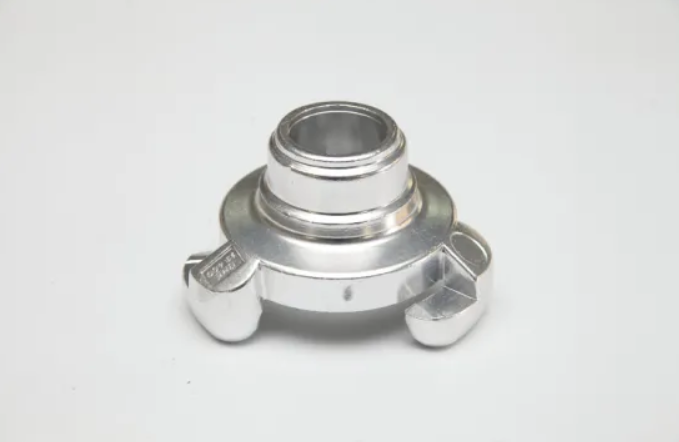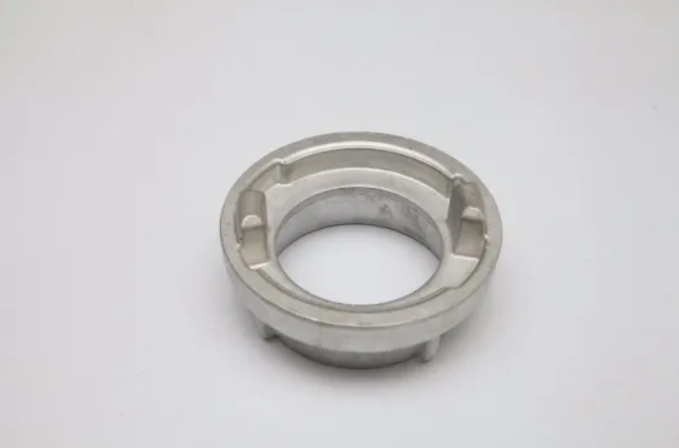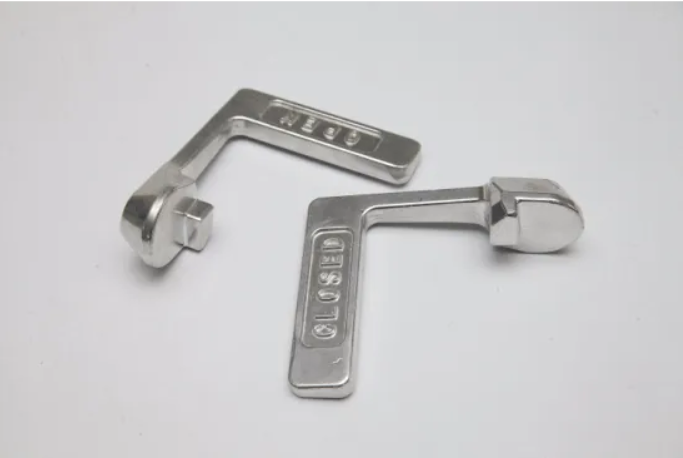Aluminum Forgings-the Choice of Lightweight Structure
Abstract: It has been proved that forged aluminum is a perfect option compared to forged steel and cast aluminum parts in the competition for reducing vehicle weight. Additionally, this choice leads to a decisive productivity improvement in the high-volume production under competitive price levels.
In terms of automotive chassis, the light weight of inelastic materials is beneficial for safety and comfort. Heinz Lowak, a doctor of engineering, argues that before he put the box with the silvery lateral guides for the front axles of the Audi A6 and Volkswagen Passat: "Our aluminum forgings weigh only half the weight of the same functional steel components, which is a decisive advantage." Meinertzhagen, the light metal technology sales and marketing department head of the Otto Fuchs company believes that aluminum can achieve very good mechanical properties through forging. The tensile strength and yield limit of the above lateral guide can reach 440N/mm2 and 380N/mm2 respectively, the elongation can be more than 10%, especially for the yield limit and elongation, the level of aluminum forgings is higher than the commonly used cast aluminum alloy.



1. High Strength and High Toughness
Castings have dominated for economic reasons in the development of aluminum components used in modern car chassis. In recent years, a series of technological solutions have been developed to make castings have better material properties. Such components can meet the high reliability requirements of chassis components that are important for life.
Jurgen Krummel, head of Audi's “Axis Parts Development” department in Ingol City argues that “there are shortcomings in forgings for a long time, such as expensive components, which often significantly limits the designer's free space for configuration optimization of component functions. Even so, forged aluminum components on the chassis still account for a large part, which can not only be explained by the high reliability requirements, but also the product liability is becoming an increasingly important factor.
For example, after overloading, the car will hit the edge of the sidewalk or deviate from the seat belt due to slippage, the wheel-guided chassis components should show visible deformation, but should not break. J. Krummel said that we call this phenomenon "leakage before breaking. This concept comes from previous configuration guidelines for steam boilers, because the pressure must have a chance to leak through the crack before the boiler explodes.
In addition to its high strength, aluminum forgings have particularly high deformability and toughness, which is accord with the above configuration guidelines. For this reason, aluminum forgings are preferred for axis parts, such as lateral guides, wheel supports, thrust rods and bearing frames.
2. Mass Production with Reasonable Price
Dr. Lowak argues that in mass production, aluminum forgings can now be processed more economically than in the mid-1980s', which will undoubtedly benefit the use of aluminum forgings. Traditionally, the users of aluminum forgings are from the aerospace sector. Until a few years ago, most of the equipment used to produce aluminum forgings was provided for small and medium-sized customers who had high requirements for product quality, which absolutely had an impact on the price structure. In recent years, a complete revolution in mass production was completed in this field. At high reliability levels, the process technology is almost as well as the steel forging process in terms of productivity, which makes the process closely linked. All working processes, such as material preparation, forging and final heat treatment based on forging temperature are integrated. "We can dramatically reduce the cost of each part in automotive industry" Dr. Lowak said. "So, in automotive industry, today's aluminum forgings can be offered at competitive prices.
3. Coordination of Materials, Processing Technology and Design
Our parts can reach high strength levels due to the long-term development of research work. Additionally, we smelt alloys ourselves, which is good for us,” explained Dr. Lowak. Because the process can be mastered in our own melting and casting factory precisely, so it is possible to optimize the process with very small tolerances. The smaller the composition tolerance of the material, the less adjustments are made in the subsequent process of the process chain. In addition, based on the precise understanding of the material properties, the direction of the fiber is directed to that of the principal stress during material formation, thereby the material strength characteristics are optimized by utilizing the significant "directional effect" of the melt. In recent years, take the static strength as an example, has been increased by about 25%.
In such developmental research involving application-related as well as fine-tuning of the complex interactions of materials and processes, people have gained a large number of experience. In this way, some particularly economical solutions can be obtained, such as direct heat treatment from forging temperatures. "In addition, it makes no sense to simply process modern steel components with aluminum in the same shape," Dr. Lowak explained. The flow of aluminum and steel is different during molding. Only forged aluminum professionals are invited to participate in the initial design stage can we get optimized results. Then, it is possible to reasonably determine the materials and processes and optimize them accordingly. To this end, there should be experienced colleagues who have mastered all the necessary methods include advanced computer systems for design, strength calculations and simulated forging processes.
"Forged aluminum shows some very interesting solutions, but I would like to point out that this process is also limited,” Dr. Lowak added. Just like any other processes, the advantages of forging aluminum can only be achieved under certain conditions. The important criteria are the complexity of the geometry and the size of the part. “Firstly, for complex geometries and a large plane, there will be limits to the manufacturability caused by price,” Dr. Lowak said. “Controlling the process to meet the requirements of reliable parts processing and even the most stringent requirements is naturally decisive for our automotive parts industry users”. In addition to the usual quality assurance, it also includes anti-corrosion protection and surface treatment. Particularly, it relies on the skills and initiative of colleagues. The increasing quality awareness in the enterprise is naturally an advantage. This tendency can be continually promoted by constant process improvement.
In terms of automotive chassis, the light weight of inelastic materials is beneficial for safety and comfort. Heinz Lowak, a doctor of engineering, argues that before he put the box with the silvery lateral guides for the front axles of the Audi A6 and Volkswagen Passat: "Our aluminum forgings weigh only half the weight of the same functional steel components, which is a decisive advantage." Meinertzhagen, the light metal technology sales and marketing department head of the Otto Fuchs company believes that aluminum can achieve very good mechanical properties through forging. The tensile strength and yield limit of the above lateral guide can reach 440N/mm2 and 380N/mm2 respectively, the elongation can be more than 10%, especially for the yield limit and elongation, the level of aluminum forgings is higher than the commonly used cast aluminum alloy.



1. High Strength and High Toughness
Castings have dominated for economic reasons in the development of aluminum components used in modern car chassis. In recent years, a series of technological solutions have been developed to make castings have better material properties. Such components can meet the high reliability requirements of chassis components that are important for life.
Jurgen Krummel, head of Audi's “Axis Parts Development” department in Ingol City argues that “there are shortcomings in forgings for a long time, such as expensive components, which often significantly limits the designer's free space for configuration optimization of component functions. Even so, forged aluminum components on the chassis still account for a large part, which can not only be explained by the high reliability requirements, but also the product liability is becoming an increasingly important factor.
For example, after overloading, the car will hit the edge of the sidewalk or deviate from the seat belt due to slippage, the wheel-guided chassis components should show visible deformation, but should not break. J. Krummel said that we call this phenomenon "leakage before breaking. This concept comes from previous configuration guidelines for steam boilers, because the pressure must have a chance to leak through the crack before the boiler explodes.
In addition to its high strength, aluminum forgings have particularly high deformability and toughness, which is accord with the above configuration guidelines. For this reason, aluminum forgings are preferred for axis parts, such as lateral guides, wheel supports, thrust rods and bearing frames.
2. Mass Production with Reasonable Price
Dr. Lowak argues that in mass production, aluminum forgings can now be processed more economically than in the mid-1980s', which will undoubtedly benefit the use of aluminum forgings. Traditionally, the users of aluminum forgings are from the aerospace sector. Until a few years ago, most of the equipment used to produce aluminum forgings was provided for small and medium-sized customers who had high requirements for product quality, which absolutely had an impact on the price structure. In recent years, a complete revolution in mass production was completed in this field. At high reliability levels, the process technology is almost as well as the steel forging process in terms of productivity, which makes the process closely linked. All working processes, such as material preparation, forging and final heat treatment based on forging temperature are integrated. "We can dramatically reduce the cost of each part in automotive industry" Dr. Lowak said. "So, in automotive industry, today's aluminum forgings can be offered at competitive prices.
3. Coordination of Materials, Processing Technology and Design
Our parts can reach high strength levels due to the long-term development of research work. Additionally, we smelt alloys ourselves, which is good for us,” explained Dr. Lowak. Because the process can be mastered in our own melting and casting factory precisely, so it is possible to optimize the process with very small tolerances. The smaller the composition tolerance of the material, the less adjustments are made in the subsequent process of the process chain. In addition, based on the precise understanding of the material properties, the direction of the fiber is directed to that of the principal stress during material formation, thereby the material strength characteristics are optimized by utilizing the significant "directional effect" of the melt. In recent years, take the static strength as an example, has been increased by about 25%.
In such developmental research involving application-related as well as fine-tuning of the complex interactions of materials and processes, people have gained a large number of experience. In this way, some particularly economical solutions can be obtained, such as direct heat treatment from forging temperatures. "In addition, it makes no sense to simply process modern steel components with aluminum in the same shape," Dr. Lowak explained. The flow of aluminum and steel is different during molding. Only forged aluminum professionals are invited to participate in the initial design stage can we get optimized results. Then, it is possible to reasonably determine the materials and processes and optimize them accordingly. To this end, there should be experienced colleagues who have mastered all the necessary methods include advanced computer systems for design, strength calculations and simulated forging processes.
"Forged aluminum shows some very interesting solutions, but I would like to point out that this process is also limited,” Dr. Lowak added. Just like any other processes, the advantages of forging aluminum can only be achieved under certain conditions. The important criteria are the complexity of the geometry and the size of the part. “Firstly, for complex geometries and a large plane, there will be limits to the manufacturability caused by price,” Dr. Lowak said. “Controlling the process to meet the requirements of reliable parts processing and even the most stringent requirements is naturally decisive for our automotive parts industry users”. In addition to the usual quality assurance, it also includes anti-corrosion protection and surface treatment. Particularly, it relies on the skills and initiative of colleagues. The increasing quality awareness in the enterprise is naturally an advantage. This tendency can be continually promoted by constant process improvement.


 sales@dropforging.net
sales@dropforging.net